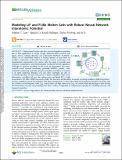Modeling LiF and FLiBe Molten Salts with Robust Neural Network Interatomic Potential
Author(s)
Lam, Stephen T.; Li, Qing-Jie; Ballinger, Ronald; Forsberg, Charles; Li, Ju
DownloadPublished version (4.704Mb)
Publisher with Creative Commons License
Publisher with Creative Commons License
Creative Commons Attribution
Terms of use
Metadata
Show full item recordAbstract
Lithium-based molten salts have attracted significant attention due to their applications in energy storage, advanced fission reactors, and fusion devices. Lithium fluorides and particularly 66.6%LiF-33.3%BeF2 (Flibe) are of considerable interest in nuclear systems, as they show an excellent combination of favorable heat transfer, neutron moderation, and transmutation characteristics. For nuclear salts, the range of possible local structures, compositions, and thermodynamic conditions presents significant challenges in atomistic modeling. In this work, we demonstrate that atom-centered neural network interatomic potentials (NNIPs) provide a fast method for performing molecular dynamics of molten salts that is as accurate as ab initio molecular dynamics. For LiF, these potentials are able to accurately reproduce ab initio interactions of dimers, crystalline solids under deformation, crystalline LiF near the melting point, and liquid LiF at high temperatures. For Flibe, NNIPs accurately predict the structures and dynamics at normal operating conditions, high-temperature-pressure conditions, and in the crystalline solid phase. Furthermore, we show that NNIP-based molecular dynamics of molten salts are scalable to reach long time scales (e.g., nanosecond) and large system sizes (e.g., 105 atoms) while maintaining ab initio density functional theory accuracy and providing more than 3 orders of magnitude of computational speedup for calculating structure and transport properties.
Date issued
2021-05Department
Massachusetts Institute of Technology. Department of Nuclear Science and Engineering; Massachusetts Institute of Technology. Department of Materials Science and EngineeringJournal
ACS Applied Materials & Interfaces
Publisher
American Chemical Society (ACS)
ISSN
1944-8244
1944-8252